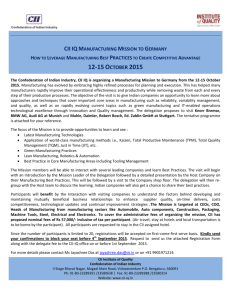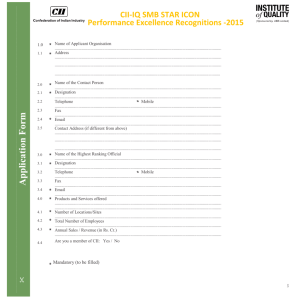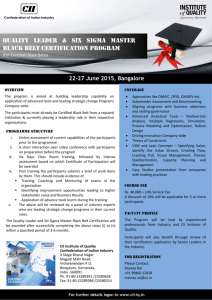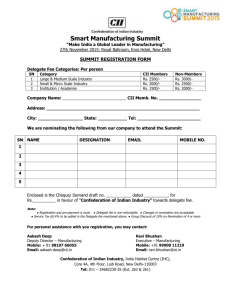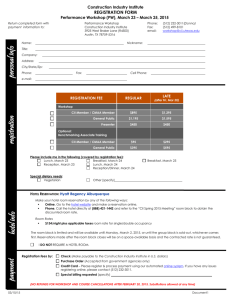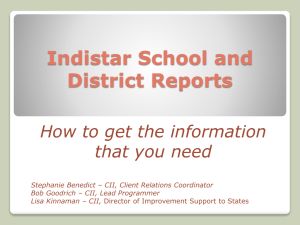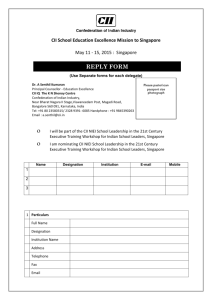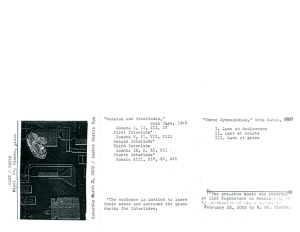Rural Business Hubs RFP: Transforming Eastern India's Economies
advertisement
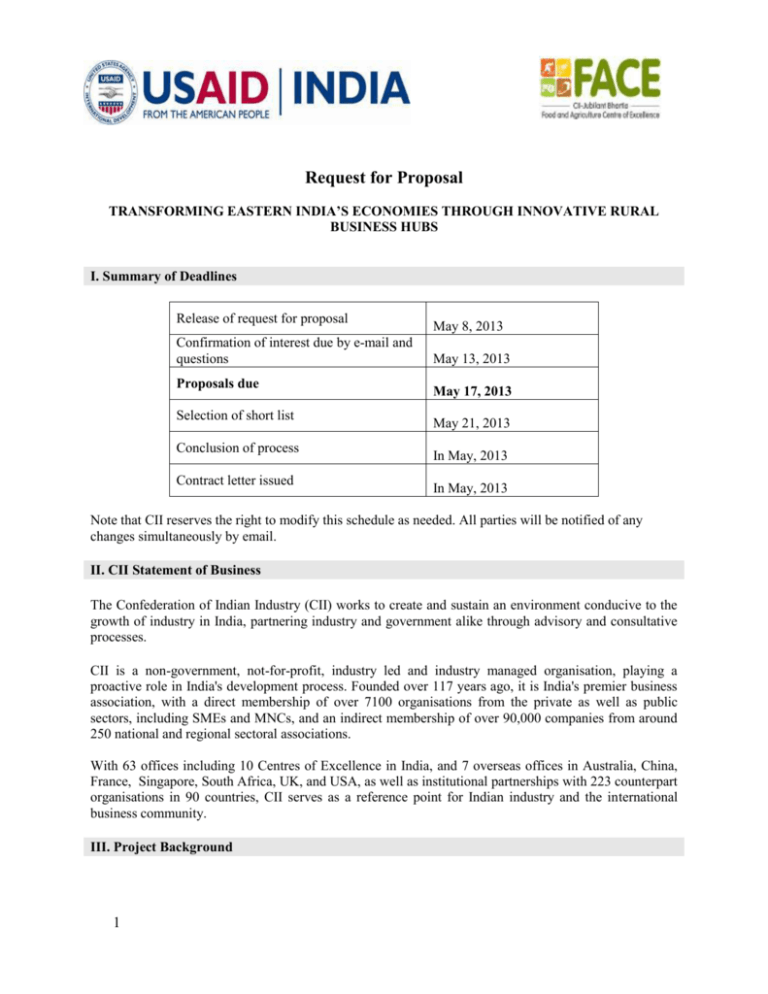
Request for Proposal TRANSFORMING EASTERN INDIA’S ECONOMIES THROUGH INNOVATIVE RURAL BUSINESS HUBS I. Summary of Deadlines Release of request for proposal Confirmation of interest due by e-mail and questions Proposals due Selection of short list Conclusion of process Contract letter issued May 8, 2013 May 13, 2013 May 17, 2013 May 21, 2013 In May, 2013 In May, 2013 Note that CII reserves the right to modify this schedule as needed. All parties will be notified of any changes simultaneously by email. II. CII Statement of Business The Confederation of Indian Industry (CII) works to create and sustain an environment conducive to the growth of industry in India, partnering industry and government alike through advisory and consultative processes. CII is a non-government, not-for-profit, industry led and industry managed organisation, playing a proactive role in India's development process. Founded over 117 years ago, it is India's premier business association, with a direct membership of over 7100 organisations from the private as well as public sectors, including SMEs and MNCs, and an indirect membership of over 90,000 companies from around 250 national and regional sectoral associations. With 63 offices including 10 Centres of Excellence in India, and 7 overseas offices in Australia, China, France, Singapore, South Africa, UK, and USA, as well as institutional partnerships with 223 counterpart organisations in 90 countries, CII serves as a reference point for Indian industry and the international business community. III. Project Background 1 A. Project Background: Project Name: Transforming Eastern India’s Economies through Innovative Rural Business Hubs Timeline: November 1, 2012 to October 31, 2014 Development Partners: CII FACE and USAID Objectives: I. Improving market efficiency by generating procurement linkages within value chains. II. Increase agriculture productivity by the increased use of agri-innovation including technology and processes and service for improved management. III. Human capacity to strengthen responses to market opportunities to improve market Competitiveness IV. Integration of stakeholders across the value chain will improve productivity and market development (though Innovative business models and balanced market systems). Background: The Confederation of Indian Industries - Food and Agriculture Center of Excellence (CIIFACE) has collaborated with the United States Agency for International Development (USAID) for a period of two years to improve agricultural productivity and output in eastern India, through the establishment of Rural Business Hubs (RBH). The RBH envisioned in this activity, will function as a one-stop aggregation point for the integration of all elements across a value chain. The RBH innovation concept implicitly recognizes that converged amalgamation of linked activities require coordination to ultimately achieve sustainable impact. RBH’s may manifest as physical, brick and mortar establishments in their deployment or virtual aggregation points, using Information Communication Technologies (ICT). While RBH models exist in various forms, common missing elements in all of them are value chain gaps like procurement linkages. Although RBH models increase market access to quality-assured agri-inputs and contribute to market transparency, they fall short of profitability and therefore are unsustainable unless new, innovative business models are developed to better harness fragmented resources and address supply and demand issues across key value chains. CII FACE will strengthen the private sector role in catalyzing agriculture productivity while integrating broader participation in select agriculture value chains in order to increase farm incomes through inclusive economic growth. Under this activity CII FACE will help improve productivity of small and medium landholders and increase income levels through inclusive growth by taking successful market-driven RBH models and innovations to scale. CII FACE will build upon the RBH investments established through the Consultative Group for International Agriculture Research (CGIAR) Collaborative Research Support Programs, foundations and donor groups to harness opportunities for growth such as in livestock, aquaculture, horticulture and tree crops and other income support activities. These will be integrated with agricultural best practices in terms of cultivation technologies, relevant and correct input supplies, critical mass generated in terms of numbers of participant farmers and aggregated land holdings, optimal utilization of agricultural infrastructures including financial support and market linkage with procurement organizations To accomplish this, CII FACE RBH will support the strengthening of value chain backward linkages to farmers in order to improve farmer capacity and productivity. CII FACE RBH will also support the strengthening of forward linkages to markets in order to improve post- harvest management including food processing, wholesale and retail marketing and distribution systems. The key to this approach is the identification of buyers to procure products identified, and specifically address top of the supply chain 2 requirements. This will require the identification of location-specific priority interventions, where each hub will serve as the convening platform that brings together a mix of resources to address forward and backward linkages. The mix of resources will be determined by the relative advantages and expertise from both the private and public sectors to ensure the integration of the key components required for creating an economical and sustainable value chain. This will include supply of agricultural inputs like seed, fertilizer, pest management and mechanization, mechanization services, extension services, finance and marketing services, agro-processing, and marketing and procurement systems CII FACE RBH will develop business models to address gaps in the agriculture value chain within the context of immature, developing and mature markets. IV. Overall Context and Purpose of RFP Overall Objective: Strengthening value chain for selected commodity in the West Bengal, Orissa and Bihar. CII intends to partner with private, public players, financial institutions and NGOs under five main broad activities as listed below to strengthen value chain, human capacities, establish procurement linkages, improve productivity and promote innovations and use of technology. 1. Access to Markets: Procurement Linkages: Establish procurement linkages to calibrate production in line with demand and provide an opportunity for economic benefits for the local economy. For example organisations that could provide support in post harvest systems with wholesale, retail procurement and distribution systems Input Supply: Input support from private sector will be in form of seeds, farm equipment, fertilizers, agrochemicals, mechanisation, pesticides, irrigation, waste management and others. The participating organisations are expected to help set up demo farms, outreach extension and training for farmers. 2. Value chain assessment: Provide support in undertaking value chain assessments. 3. Technology Service: Facilitate introduction and adoption of innovations and technologies that help improve productivity and farmer’s incomes. For example, use of technology for price discovery, weather information and other similar such services. These services could include setting up of ICT solutions, monitoring creation of demo farms, on farm productivity across the value chain, productivity trainings and trainings to hub centres. 4. Extension and Capacity Building: Rural Business hubs will deploy innovation and innovative sustainable business models to decrease opportunity cost that will result in increased productivity as a result of better agriculture resource and management practices. For example organisation who could provide FPO mobilization and need identification, training on productivity improvement, harvesting methods, post harvest and waste reduction, weather and crop protection etc. 5. Access to Finance: Provide access to finance to farmers for purchase of inputs and other related services. For example, financial organisation who could conduct financial literacy training, provide innovative credit instruments to farmers, includes purchase inputs, weather insurance , working capital requirement etc. 3 Interested organizations may submit proposals to contribute to ACTIVITY # 2 i.e. Baseline Study and Supply Chain Assessment NOTE: THIS RFP IS TO INVITE PROPOSALS FROM ORGANISATIONs WHO WOULD LIKE TO BE A PART OF A CONSORTIUM TO CONTRIBUTE TO ACTIVITY NUMBER TWO i.e. VALUE CHAIN ASSESSMENT. ORGANISATIONS HAVING EXPERIENCE IN CONDUCTING VALUE CHAIN STUDIES ARE INVITED TO SUBMIT THEIR PROPOSALS IV. Scope of Work and Deliverables – BASELINE STUDY AND SUPPLY CHAIN ASSESSMENT A. Scope of Work: Activity: Value Chain Analysis Objective: Conduct value chain analysis for Banana and Vegetables value chain in West Bengal, and Bihar respectively. Timeline: Within two months from the time of agreement. Area: North Eastern Region - West Bengal, and Bihar Profile of Organizations: Research organization, educational institutions Commodity: Being identified in each state through parallel process Value Chain activities: The Value Chain analysis looks at the whole process of effective utilization of resources to create a competitive advantage that would provide a lower cost and better improved profit margin. Value addition tends to create the following: Identifying the specific commodities for value chain Economies of scale Capacity utilization Linkages among activities including vertical integration Learning process Interrelationships among business units Marketing outlets Value chains encompass the full range of activities and services required to bring a product or service from its conception to sale in its final markets—whether local, national, regional or global. Value chains include input suppliers, producers, processors and buyers actively supported by a range of technical, business and financial service providers. The main purpose of this intervention is to carry out an analysis and assessment of potential value chains and linkages in the agricultural and agro-based sector. This would create a platform for development of a blue-print for strengthening of value chain from farm to fork activities. Expected Role: The organization is expected to help us address the following questions and provide information against required parameters under baseline section below to meet project results 4 1. Mapping the value chain Mapping the value chain of existing private sector Map backward linkages that are economically viable Map Farmer organisation lead farmers, self-help groups, federations and societies Map potential forward linkages to markets including post-harvest production and processing services Chain stakeholders: visualize the relations between actors and stakeholders: i. Actors and their functions ii. Supporters and their functions iii. Influencers and their functions iv. Disaggregated data of beneficiaries by male/female, small holder farmer vs. wealthier medium sized farm holders 2. Bottlenecks along the value chain Covering at least: What are the market opportunities? For which products and from which markets is there a demand? What are the key bottlenecks preventing strengthening of value chain? Are these bottlenecks critical? Can these bottelnecks be addressed in a reasonable timeframe? What bottlenecks can be solved by CII FACE? What are the resource requirements to address these bottlenecks? Summary: What are the main constraints (cluster constraints to max 8 key issues)? 3. Baseline information The key results that project is committed to deliver are: Increased net incomes (on and off farm) for households engaged in the target value added market chains Increased productivity and decreased opportunity cost for improved productivity as a result of better agriculture resource and management practices Decreased post harvest losses for targeted value chain Increased application of post harvest market information. Access to financial and risk management products by household in target population Baseline study will collect information on following suggested parameters but not limited to only these one. The questionnaire can be finalized after the finalization of agreement with the agency 5 (Estimated) number of farmers active in the chain/product groups Estimated income levels (Estimated) value addition activities at each step of the value chain Current productivity volumes and amounts for the selected value chain Post Harvest loses Trends in supply and demand Data on exiting vs. required financial assistance and actors 4. Deliverables: What steps are needed to ensure that the value chain performs well? Proposed CII activities to support value chain for selected commodity. How much increase in income is expected to result from the CII FACE intervention (target and attribution estimation)? How much increase in productivity is expected to result from the CII FACE intervention How much decrease in post harvest loses is expected to result from CII FACE interventions What are the kind of financial instruments and risk management strategies are required to ensure strengthening of value chain What are opportunities for synergies due to integrated approach/alliances with other organisations actively supporting that value chain? Risk analysis Baseline study results with suggested indicators for measuring the outcome after two years of the project Responsibilities of the Bidder The chosen contractor will be responsible for organizing and managing the logistics of conducting the fieldwork, including the provisioning of a team of interviewers capable of administering the questionnaires in local language; the provision of transport and lodging of the teams of interviewers during the field work; processing, conducting basic analysis and presenting in a packaged report to CII FACE for further analysis and reporting. The interviewers and their supervisors should be able to communicate fluently in (local language). All interviewers need to be able to read and write in local language as well. The bidder need to specify survey methods along with details of the sample for each survey instrument which they usually consider appropriate. Responsibilities of CII FACE: 1. CII FACE will provide overall management, technical inputs as and when required, particularly in the areas of finalizing the study instrument, and guiding the analysis and baseline study at several points. 2. Provide a list of and a map of project sites in three regions 3. Provide introduction of field investigators to the sites, and on-site support to them through CII FACE field offices. V. Costs Provide itemized costs for the total scope of this project, based on the scope of work and deliverables outlined in Section IV. The final scope of work may be subject to negotiation; however, bidder selection will be made against the original scope of work. Bids should follow the following budget format: (change, add, or delete items in the list as required.) 6 A line item budget, in Indian rupees, is to be presented with Unit Rates, Person Days and Timelines as per the sample budget format attached, showing anticipated costs of the proposed research activities. All projected costs must be in accordance with the organization’s standard practices and policies. Table 1: Sample Form for Budget Details by Line Item Sr. No 1. Particulars Personnel Costs Unit # of Units Rate Amount Cost/activity/ for person (specify daily rate X # days) Others (specify) Sub-total 2. Travel and Transportation Mode/# and cost per trip Local expenses Others (specify) Sub-total Training of Field Teams for Data Collection # Interviewers X rate per day during training Venue hiring/food and drink costs Vehicle hire Per diems Others (specify) Sub-total Data Collection and De-briefing in the Field 3. 4. Sub-total Any other 6. Sub-total Tax GRAND TOTAL Offers may include additional line items as and where necessary, and with appropriate justification in the Budget Notes. 7 VI. Overall Qualifications Provide information on your overall qualifications, including Profile of relevant corporate qualifications. Professional expertise with qualitative and quantitative aspects of value chain and baseline analysis. Qualifications of key members of the proposed project team (attach CVs and provide details of back-up/standby teams). Number of years in business. If your company has more than one location, please indicate these qualifications for the site that is responding. VII. Proposal Evaluation Criteria The following is a list of significant criteria against which proposals will be assessed. The criteria are listed in order of priority, however they are not weighted. CII FACE anticipates issuing a firm fixed-price sub-agreement to the offeror whose proposal is most advantageous and cost-effective. A fixed-price contract calls for one price, not subject to any adjustment based on the offeror’s cost experience in performance of the contract. This fixed-price is established at the outset, when the contract is negotiated and signed. Proposals will first be evaluated from a technical standpoint. Those proposals that are considered to be technically acceptable shall then be evaluated in terms of cost. Each technical proposal will be evaluated based on evidence of the following items: CRITERIA TECHNICAL CRITERIA (35 points) Proposals reflects understanding of project and the scope of work in the RFP Proposal illustrates knowledge of value chain analysis and baseline survey methods along with details of the sample for each survey instrument which is usually considered appropriate Clearly demonstrates knowledge and understanding of the value chain analysis and baseline questions and objectives across the value chain and can justify the selected methodology for meeting the stated objective(s) as outlined in the SOW Experience conducting value chain analysis and baseline studies quantitative and qualitative analysis Sub Total QUALIFICATIONS and EXPERIENCE (30 points) Qualifications and Experience of the project team Experience of the organization in similar work Experience of working in East India and working experience with other value chain players Sub Total WORK PLAN (20 points) Clear outline of steps and activities to achieve deliverables Having required personnel on the team 8 Scores 8 8 9 10 35 10 10 10 30 7 6 Capacity to perform the work within the desired timeline Sub Total COST (15 points) Appropriateness of the budget to the plan suggested vis-à-vis institution/staff experience and qualification Sub Total GRAND TOTAL 7 20 15 15 100 Note: CII reserves the right to include additional criteria. VIII. Instructions for Responding A. CII contacts: Procurement Contact: Tarun Tandon (tarun.tandon@cii.in) Technical/Program Contact: Meetu Kapur (meetu.kapur@cii.in) D. Proposals due: May 17, 2013 Completed proposals in the format below should be submitted by email to the contacts listed above. The subject line of the email should read: Transforming Eastern India’s Economies Through Innovative Rural Business Hubs Organization Description Period of Performance Methodology of contribution to the objectives as outlines in section IV Work plan and deliverables Manpower required to conduct the value chain analysis and baseline study Budget including contributions (in cash or kind) E. Selection of short-list CII reserves the right to select a short list from the bids received. CII has the option to interview and discuss specific details with those agencies who are on the short-list. F. Conclusion of process Applicants will be notified of CII’s decision in May 2013. Final award is subject to the terms and conditions included in this solicitation, as well as successful final negotiations of all applicable terms and conditions affecting this work. IX. Terms and Conditions of the Solicitation A. Notice of non-binding solicitation CII reserves the right to reject any and all bids received in response to this solicitation, and is in no way bound to accept any proposal. All the work produced under this RFP will be sole property of CII FACE. B. Data All the raw and final data collected by the organization will be handed over to CII FACE in soft and hard copies. 9 C. Confidentiality All information provided by CII as part of this solicitation must be treated as confidential. Proposals, discussions, and all information received in response to this solicitation will be held as strictly confidential, except as otherwise noted. D. Communication All communications regarding this solicitation shall be directed to appropriate parties at CII indicated in Section VIII. A. Contacting third parties involved in the project, the review panel, or any other party may be considered a conflict of interest, and could result in disqualification of the proposal. E. Acceptance Acceptance of a proposal does not imply acceptance of its terms and conditions. CII reserves the option to negotiate on the final terms and conditions. We additionally reserve the right to negotiate the substance of the finalists’ proposals, as well as the option of accepting partial components of a proposal if appropriate. F. Right to final negotiations CII reserves the option to negotiate on the final costs and final scope of work. G. Third-party limitations CII does not represent, warrant, or act as an agent for any third party as a result of this solicitation. This solicitation does not authorize any third party to bind or commit CII in any way without our express written consent. 10
